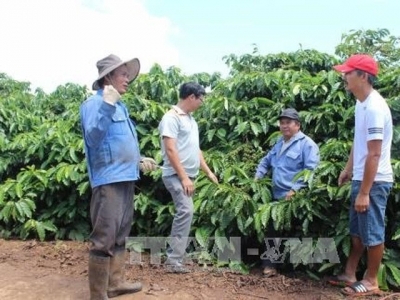Gia Lai farmers struggle to find higher prices for VietGap coffee

Farmers work at a large coffee field in Gia Lai Province’s Đăk Đoa District. – VNA/VNS Photo
HCM CITY – Local authorities and farmers who grow coffee under Vietnamese Good Agricultural Practices (VietGap) in Gia Lai Province are seeking a better selling price for their coffee because of its higher quality.
Last year, 60 households in Ia Gôn Village took part in the VietGap Robusta Coffee Planting Team in Đức Cơ District’s Ia Krêl Commune, under the support of the commune’s People’s Committee and the district’s Agriculture and Rural Development Bureau.
Under the programme, local authorities promised that they would try to find buyers for their products, but have not been successful so far.
The farmers growing coffee trees under VietGap standards follow strict planting processes, including fertilisng methods and time, ripening rate of harvested coffee, and preservation methods.
Lê Viết Hợp, a team member who owns 1.5 ha of coffee trees, said his family harvested six tonnes of coffee beans last year, but could not find a buyer who was willing to pay higher prices.
After waiting for about 1.5 months, he sold the coffee beans to buyers who paid the price for normal coffee.
“Although I felt very sad, I did not know what to do,” he said, adding that he had to sell for cash flow reasons.
Nguyễn Sĩ Hậu, who is part of the planting team, has stocked seven tonnes of VietGap coffee in his house.
He said that planting VietGap coffee was strict and production costs were high, but he could wait to sell his coffee at a higher price.
Hoàng Xuân Thủy, head of the planting team, said one company offered to buy the team’s coffee at VNĐ500 a kilo higher than normal coffee but it never returned.
Last year, the team harvested about 500 tonnes of coffee on 100 ha of coffee trees planted under strict VietGAP standards.
Of the figure, farmers had to sell about 150 tonnes at normal prices, but they stocked the remaining to wait for a better price, according to the Ia Krêl Commune People’s Committee.
Siu Luynh, chairman of the Ia Krêl Commune People’s Committee, said the People’s Committee was working with the district’s Agriculture and Rural Development Bureau to call on local coffee-buying establishments to guarantee outlets for VietGAp coffee.
The People’s Committee is also encouraging farmers to continue planting VietGAp coffee.
As of the end of December, the Tây Nguyên (Central Highlands) province had 130 ha of VietGap coffee, including 130 ha in Đức Cơ District and 30 ha in Pleiku City, according to the province’s Agriculture, Forestry and Fishery Quality Management Sub-department.
Lê Huy Toàn, head of the sub-department, said: “We guide farmers planting VietGAP coffee in teams so that production processes can be monitored strictly, ensuring coffee quality.”
“We’ve organised fairs and meeting activities for coffee buyers and farmers to promote the coffee production chain,” he said.
Replanting old coffee trees
Gia Lai, which has one of the largest coffee areas in the country, has more than 90,000 ha of coffee trees. Of the figure, trees on 18,000 ha are old and should be replanted by 2020, according to local authorities.
To improve coffee quality, local authorities supported farmers in replanting old coffee trees.
Farmers can borrow a loan of VNĐ150 million (US$6,600) at a preferential interest rate per ha to replant old coffee trees.
Last year, farmers in the province replanted more than 3,500 ha of old coffee, exceeding 40 per cent of the target.
By 2020, the province aims to establish 4,000ha of large-scale coffee fields in major coffee cultivating areas like Đức Cơ, Chư Prông, Ia Grai and Đăk Đoa districts.
In Đăk Đoa District, more than 100 households in Nam Yang Commune have set up a 120-ha, large-scale coffee field.
Related news
 Fruit and vegetable exports yield sweet results
Fruit and vegetable exports yield sweet results Moving ahead of rice, oil and gas - Vietnam’s traditional and key export products - fruit and vegetable topped the list of agricultural exports in 2017
 Value adding problem for pepper
Value adding problem for pepper Facing the inadequacies due to the recent fast area increase, the pepper industry has made certain changes in production and processing
 Fruit & vegetable trade up in January
Fruit & vegetable trade up in January Exports at $320 million and imports $160 million in first month of new year, up 37% and 57% year-on-year.